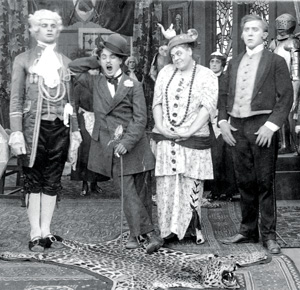

OVER THE last century, Charlie Chaplin’s early films were often seen in grimy, jerky prints, so dim they made the plots impossible to understand. The new four-DVD set Chaplin at Keystone from Flicker Alley sweeps away cobwebs from Chaplin’s yearlong work at Mack Sennett’s studio.
The project is the result of collaboration between several film archives and includes a sprightly, stock-footage-laden short by Pauline Richard, explaining how silent films are restored.
On the Keystone assembly line, the custom was to make 50 prints for the entire world market from a negative that was by no means kept pristine. It is a testament to Chaplin’s rabid popularity that 34 of his 36 Keystone films are here and accounted for; there’s even a recently discovered chunk of a 35th film.
When Chaplin came to America, slapstick pioneer Sennett recollected that he “could fall, trip, stumble, somersault and make faces. These were stock-in-trade items that we could use. I did not see then … the subtleties and pathos.”
Here are only glimpses of the later Tramp, with his insistence (as essayist Robert Warshow put it) that a clown’s sorrows are the deepest sorrows. Chaplin’s burlesque of the poem “The Face on the Barroom Floor” doesn’t give the soggy doggerel a chance. When Chaplin loves and loses at this point of his career, he expresses it through what looks like an epileptic fit.
And yet, here is a silent comedian going against the grain of everything in the screen comedy of 1914. Chaplin is a man of extremes: wearing clothes too loose or too tight, with size-5 feet in size-14 shoes, wearing a mustache on a child’s face. He cuts a dignified, finicky figure amid slum dwellers. He is also a kind of two-legged cockroach distressing fancy diners and tea dancers.
Kid Auto Races at Venice marks the screen debut of the Tramp character, on Feb. 7, 1914. This must be counted as one of the first mockumentaries. Released, says Sennett, on the same reel as a promotional film titled Olives and Their Oil, we see a soap-box derby at the L.A. beach town interrupted by a what seems to be a persistent amateur, waddling like a penguin, who cannot stop scowling into the camera.
Chaplin isn’t always a tramp, even; at times, he appears as a well-dressed scoundrel. He found his way at Keystone through the help of the first great film comedienne, Mabel Normand. The two are a treat in Mabel’s Busy Day, where her attempt to sell hot dogs at a racetrack is defeated by mooches on all sides. Normand works the sympathies of the crowd while surreptitiously licking the mustard off her hands. Charlie plays a thief, seizing the wieners and passing them around for free. Normand, a figure from whom Gwyneth Paltrow, Carole Lombard and Olive Oyl are all directly descended, defends herself handily.
Jeffrey Vance’s well-written booklet describes the innovation that Chaplin brought to this year in silent comedy. Where Keystone emphasized slapstick finished by a cross-town race, Chaplin preferred the slow development of character bits, not a fascination with impact but with the build-up.
Chaplin entered a world of violent slapstick and situational comedy. He left after starring in the first full-length comedy feature, Tillie’s Punctured Romance, in which a duded-up Chaplin and his girlfriend (Normand) bamboozle a wealthy heifer (Marie Dressler). The restored version credits the help of everyone from Tony Scott to the Stanford Theatre’s David W. Packard.
The film is as knockabout as anything else on the set, but the comedic power of extended narrative is visible. And the limitations of the two-reel slapstick film are being transcended as we watch,Even before he left Keystone for Essanay and his locally well-known three-month stint in Niles in early 1915, Chaplin had changed the focus to a star holding the stage, slowly building a routine. Hold up his A Film Johnnie next to Keaton’s Sherlock Jr. and see that Chaplin was pointing the way to the future.
If the cowboy goes off alone at the end of the movie, he learned that from Chaplin. The “delirious egotism” found by David Thomson in Chaplin is present in Gene Kelly and Fred Astaire. It is found in Garbo’s close-up and in the pregnant silences of every method actor. Chaplin took what was considered hired-hand work in a novelty factory and changed it irrevocably.
Chaplin at Keystone
Flicker Alley
$79.95



